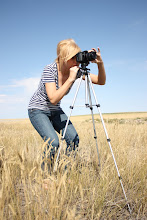Part One
The Right Equipment
Basic Kit
According to Tim Fitzharris, writer of "Nature Photography," the type of camera that most photographers, whether professional or just beginning, rely heavily upon an SLR digital camera (SLR standing for "single-lens reflex.")
Fitzharris explains in the first section of the book that there are a lot of major advantages for having a SLR digital camera. These cameras are fairly more accessible and easy to use then "traditional" film cameras from the past. He talks about how it is easier to enlarge a digital picture and how the quality of that picture will be better than a film produced composition.
Another upside to the digital SLR is the "ability to adjust ISO speed of individual takes to match shooting conditions." There are many programs out today, such as Photoshop and Photoshop Elements that also can help to tweek these types of things on a computer.
Tim Fitzharris also strongly recommends the purchase of a tripod. This tool comes in extremely handy when you are trying to shoot darker areas with less light and need to use a slower or extended shutter speed on your camera. This stabilizes the camera and allows the camera to take a significantly clear photo. He recommends that tripods with tubular legs are the best way to go. He also mentions that metal legs are really heavy, cold in the winter, and hot in the summer, so can result in problems while hiking to shoot. Fitzharris also recommends that photographers start out using a ball head on their tripods instead of pan/tilt heads with levers. Ball heads are just easier to use all the way around.
For shooting wildlife, Tim explains that a photographer will need to get a super-telephoto lense to capture wildlife from a distance and still achieve clear, brilliant photographs. He explains that the "ultimate in super-telephoto lens quality" is within the Canon's image stabilizer or if you use a Nikon (silly people, Canon's the way to go! :) ) it is called the vibration reduction. All new lenses supply these two tools and are very VERY useful in the field.
Simple zoom lenses are recommended by Fitzharris for landscaping photography. This is so you can capture more area than you particularly wouldn't if using a super-telephoto lense.

No comments:
Post a Comment